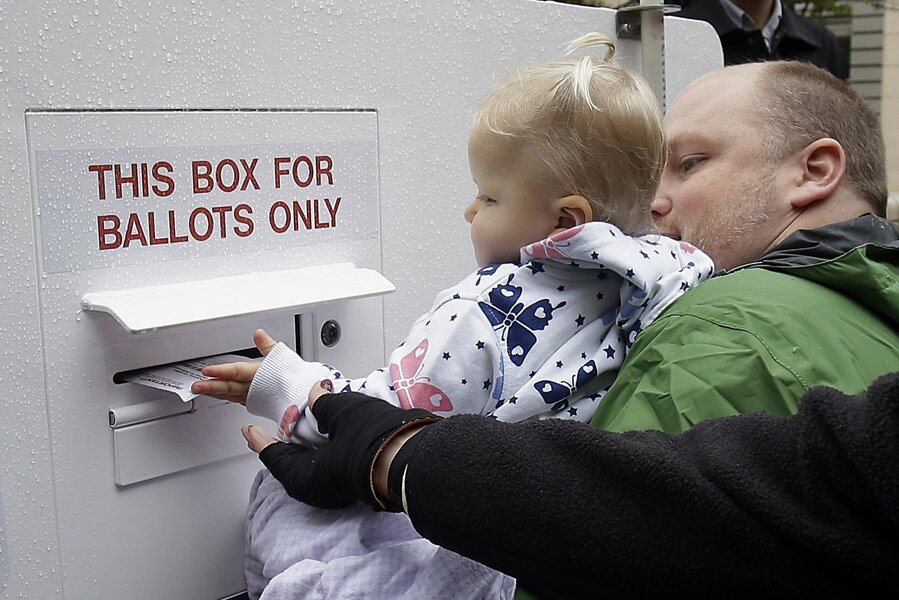Voter turnout: Are surprise candidates fulfilling their campaign promise?
Loading...
Californians are registering to vote in record numbers, as both young voters and older new American citizens want their say in a still-contentious presidential primary.
Unorthodox presidential contenders from both parties boast success on their first campaign promise as record numbers of voters continue to turn out for primary elections across the United States, although analysts debate whether that is because of personal appeal or simply a rising interest in a contentious election.
A record 850,000 voters registered for the California primary in June, far above the numbers seen in either 2008 or 2012, John Wildermuth reported for the San Francisco Chronicle. Many are Democrats eager to weigh in on the party's nominating process. Voting officials said young voters are leading the charge, although many older Latinos are also registering.
The California surge has been consistent since the beginning of the primary election season, as voter registration was up by 230,000 voters as of April 8, and almost 200,000 registered during a two-day Facebook push this week, ahead of Monday's registration deadline for the June 7 primary, as the Associated Press reported.
Although translating voter registration into turnout is not always a smooth process, Senator Sanders' campaign is calling this a success, as the Vermonter has long insisted that bringing hordes of non-voters to the polls is his strategy for success.
"If voter turnout is low, if young people and working people don't send in their ballots, we will probably lose," Sanders told The Oregonian during the Oregon primary. "Needless to say, what I hope we'll be seeing is a very large voter turnout."
Democrat-leaning voters in the Western states are answering the call, although they have waited until somewhat later in the campaign than Sanders may have hoped. He won the Democratic primary in Oregon, which saw an unusual jump in voter registration, especially among voters under 30.
"[T]here's clearly a lot of interest out there," Oregon Secretary of State Jeanne Atkins told The Oregonian. "We have more registered voters than we've ever had before."
Sanders won the three contests with the highest voter turn-out: Oklahoma, New Hampshire, and Vermont – although Politico reported that he also won the 10 states with the lowest voter turn-out.
Any turnout predictions in the general election are complicated by the similar claims made by Republican candidate Donald Trump, who has promised his outsider appeal will interest previously apathetic voters in the primary and general election, Shane Goldmacher reported for Politico.
"All you have to do is take a look at the primary states where I've won and just look – we've gone from X number to a much larger number," Mr. Trump said on Super Tuesday. "That hasn't happened to the Republican Party in many, many decades. So I think we're going to be more inclusive."
Turnout for Republicans hit record highs in Iowa, South Carolina, and Florida, where it jumped 40 percent above 2012 numbers. Analysts have expressed some skepticism about whether the new records are being set by first-time voters, but the same primary that has surprised political pundits has also generated an interest unprecedented in recent elections.
The theory of the "missing white voter" who sat out the 2012 election, helping to hand it to President Obama, has fueled hopes that Trump's populism could draw them back to the polls for a GOP victory. But to secure a win, their return would have to happen under several conditions, as The Christian Science Monitor's Peter Grier reported in January:
They'd have to get virtually all these people to vote, and for only them – no defections to the Democrats allowed.
Those revitalized voters would also have to be grouped enough to make a difference in swing states. As Amy Walter noted in a 2015 Cook Political Report analysis of the "missing white voter" theory, those who stayed home seem to disproportionately live in noncompetitive states. Increasing white turnout in Alabama, for example, would not help the GOP very much.
And crucially, any attempt by Republicans to reach and motivate missing white voters would probably have the unintended effect of also mobilizing Democratic nonwhite voters.








